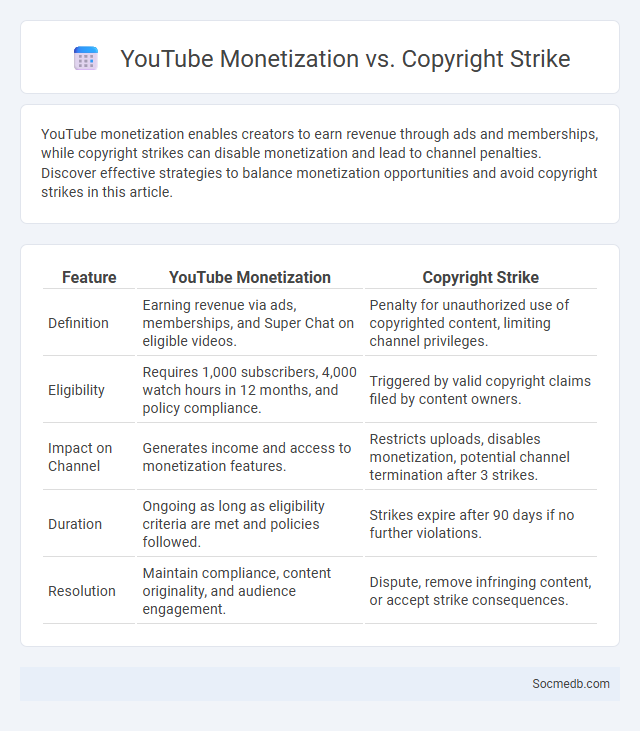
Photo illustration: YouTube Monetization vs Copyright Strike
YouTube monetization enables creators to earn revenue through ads and memberships, while copyright strikes can disable monetization and lead to channel penalties. Discover effective strategies to balance monetization opportunities and avoid copyright strikes in this article.
Table of Comparison
| Feature | YouTube Monetization | Copyright Strike |
|---|---|---|
| Definition | Earning revenue via ads, memberships, and Super Chat on eligible videos. | Penalty for unauthorized use of copyrighted content, limiting channel privileges. |
| Eligibility | Requires 1,000 subscribers, 4,000 watch hours in 12 months, and policy compliance. | Triggered by valid copyright claims filed by content owners. |
| Impact on Channel | Generates income and access to monetization features. | Restricts uploads, disables monetization, potential channel termination after 3 strikes. |
| Duration | Ongoing as long as eligibility criteria are met and policies followed. | Strikes expire after 90 days if no further violations. |
| Resolution | Maintain compliance, content originality, and audience engagement. | Dispute, remove infringing content, or accept strike consequences. |
Understanding YouTube Monetization: An Overview
YouTube monetization allows content creators to earn revenue through ads, channel memberships, and Super Chats by joining the YouTube Partner Program, which requires at least 1,000 subscribers and 4,000 watch hours in the past 12 months. Your ability to generate income depends on factors like video engagement, niche, and adherence to YouTube's policies and community guidelines. Maximizing earnings involves optimizing content for SEO, maintaining consistent uploads, and understanding analytics to tailor videos to audience preferences.
What is a Copyright Strike on YouTube?
A copyright strike on YouTube occurs when a user uploads content that infringes on someone else's copyrighted material, such as videos, music, or images, without proper authorization. Receiving a copyright strike can lead to restrictions on your YouTube account, including video removal, account suspension, or termination after multiple strikes. Understanding YouTube's copyright policies and using original or licensed content helps protect your channel from these penalties.
The Difference Between Copyright Claim and Copyright Strike
A copyright claim on social media indicates a copyright owner has detected their content usage and may monetize or track the video without removing it. A copyright strike is a more severe action that typically results in content removal, account restrictions, or penalties, often after repeated violations. Understanding the distinction helps content creators manage risks and maintain compliance with platforms like YouTube, Facebook, and Instagram.
How Monetization is Affected by Copyright Strikes
Monetization on social media platforms is significantly impacted by copyright strikes, as these violations can lead to demonetization or removal of revenue-generating features from content creators' accounts. Platforms like YouTube and Facebook enforce strict copyright policies, causing earnings to be withheld or redirected to the original copyright holders when strikes occur. Repeated copyright strikes can result in account suspension or termination, further restricting creators' ability to monetize their content effectively.
YouTube’s Copyright Rules: What Creators Need to Know
YouTube's Copyright Rules are crucial for creators aiming to protect their content and avoid strikes on their channels. Understanding fair use, content ID claims, and proper licensing helps You manage your videos without infringing on others' intellectual property. Staying informed ensures your creative work remains available and monetizable on the platform.
The Impact of Copyright Strikes on Channel Revenue
Copyright strikes on social media platforms directly affect your channel revenue by limiting monetization opportunities and reducing ad placements. These strikes often lead to demonetization, suspension of content, and loss of sponsorship deals, significantly cutting your income streams. Protecting original content and understanding copyright policies are essential to maintaining consistent revenue growth.
Steps to Avoid Copyright Strikes While Monetizing
To avoid copyright strikes while monetizing on social media, consistently use original content or obtain explicit licenses for third-party materials such as music, videos, and images. Employ content identification tools like YouTube's Content ID to pre-check for potential copyright conflicts before publishing. Regularly review platform policies and stay updated on changes to ensure compliance with copyright laws and monetization guidelines.
Resolving Copyright Strikes and Claims on YouTube
Resolving copyright strikes and claims on YouTube requires a clear understanding of copyright laws and YouTube's Content ID system. You can submit a counter-notification if you believe your content was wrongfully flagged, ensuring you provide accurate and detailed information to support your case. Timely resolution helps protect your channel's standing and maintain audience trust while safeguarding your creative rights.
Fair Use and Its Role in Monetization and Copyright
Fair Use plays a critical role in social media by allowing users to share copyrighted content within specific limits, fostering creativity and engagement without infringing on intellectual property rights. Your ability to monetize content hinges on understanding Fair Use principles, which include factors like purpose, nature, amount, and effect on the market value of the original work. Navigating these guidelines ensures you can legally use and profit from content while respecting copyright laws.
Best Practices for Safe and Successful YouTube Monetization
Maximize YouTube monetization success by consistently adhering to community guidelines and copyright policies, which protect content and ensure channel longevity. Optimize video metadata with relevant keywords, engaging titles, and detailed descriptions to enhance discoverability and viewer engagement. Regularly monitor analytics to refine content strategies, foster audience growth, and maintain compliance with YouTube's monetization standards.
 socmedb.com
socmedb.com